
views
Using a Room Divider
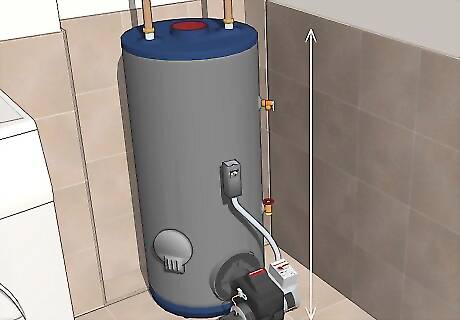
Measure the height of your water heater. Start your measuring tape at the bottom of your water heater and extend it to the full height of the water heater. Include the height of any pipes that extend up and out from the top of the water heater if you also want to conceal them. Write down your measurement as soon as you take it so you don’t forget. You may also measure the width and depth of the water heater, but these measurements are not as important as the height since you can adjust how long a room divider is.
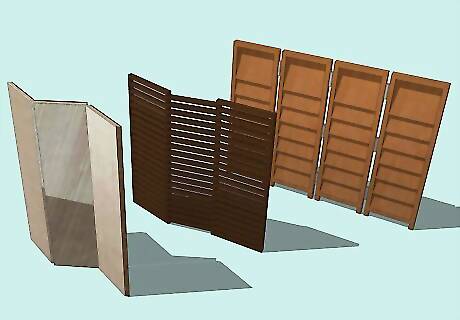
Buy a room divider that completely hides your water heater. Visit a home goods store or shop online for multi-panel room dividers that will fit in your space. Look for one that is tall enough to conceal the water heater and is able to wrap around the sides. Try to find a divider that matches the design in the rest of the room so it doesn’t stand out or seem out of place in your room. If you can’t find a room divider that can completely cover the water heater, you may need to buy multiple. Room dividers can be made from many different materials and with different designs. Choose one that fits best in your space.
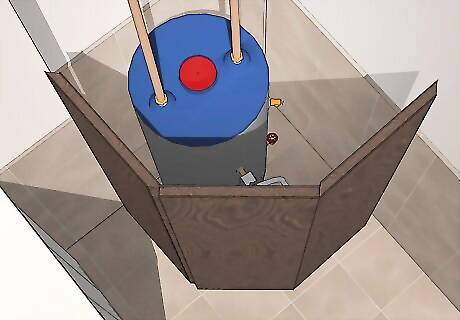
Surround your water heater with the room divider. Stand the room divider up and pull the panels apart so it doesn’t fall over. Push the divider about 6 inches (15 cm) in front of the water heater so one edge is against the wall. Pull the other end of the divider to extend and wrap it around the water heater until you can't see it anymore. Whenever you need to access the water heater, push the divider against the wall.Warning: Don’t rest the divider against a gas water heater since it could be a fire hazard.
Hanging Curtains around the Heater
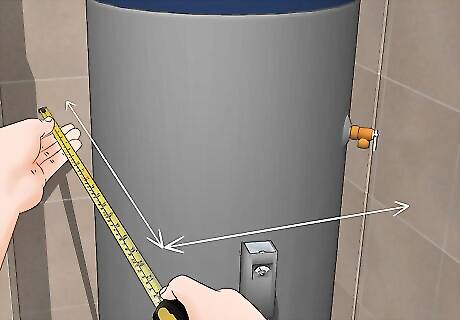
Measure the width and depth of the water heater. Extend a tape measure out from one wall until you’ve reached the outer edge of the heater. Write down your measurement and add about 4–5 inches (10–13 cm) to it so the curtain has some space between it and the water heater. Take the depth measurement from the second wall behind the heater to the furthest point it extends out. Add another 4–5 inches (10–13 cm) to the measurement to add a buffer. Don’t install your curtain so it directly touches the water heater since it could create a fire hazard.
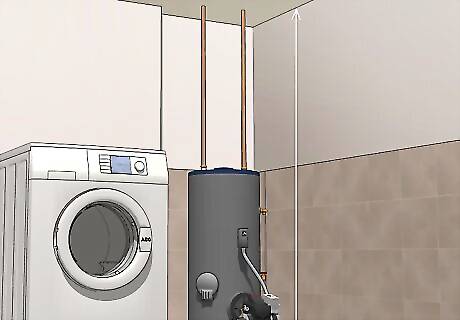
Find the height of your ceiling. Start your tape measure on the floor near your water heater and pull it straight up until you reach the ceiling. Ensure that the tape is perfectly vertical or else your measurement will be wrong. Write down your measurement so you don’t forget it and so you know how long your curtain needs to be.
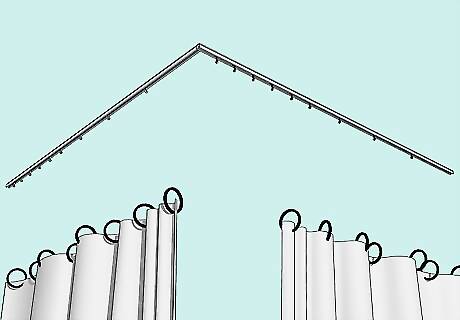
Buy ceiling curtain track that’s the same length as the width and depth combined. Curtain track is a metal piece that you can hang a curtain from the ceiling with. Get a length of track to install directly on your ceiling that matches the combined length and width measurements you took. If you want your curtain to wrap around the water heater completely, then get angled corner sections of track as well. You can buy curtain tracks from home good stores or online. If you can’t find the exact length that you need, use a hacksaw to cut the track to size.
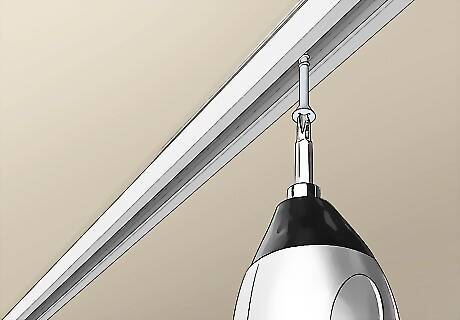
Screw a piece of curtain track on the ceiling. Position the end of the first track section against the wall so it extends out past your water heater. Make sure the track isn’t crooked on the ceiling before feeding screws into the holes along it. Use an electric screwdriver to secure the screws so the track stays in place.Tip: If you’re putting your screws into drywall, use anchors before you put them in or else the track could fall out of place.
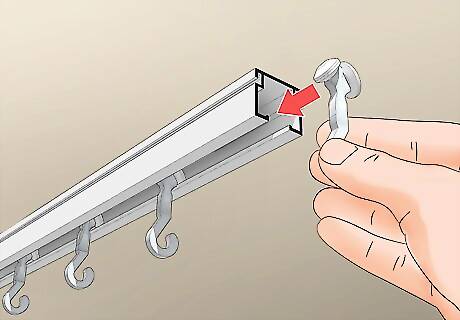
Slide the curtain hooks onto the first piece of track. Make sure to use curtain glider hooks that match the width of your track. Push the round end of the hook into the track and slide them to the end. Add as many hooks as you need for your curtain right away since it’s more difficult to put hooks on once you finish the rest of the track. You can buy curtain glider hooks from home goods stores or online. Hooks come in multiple sizes and styles. Get hooks that match the hardware in the rest of your room so they don’t stand out too much.
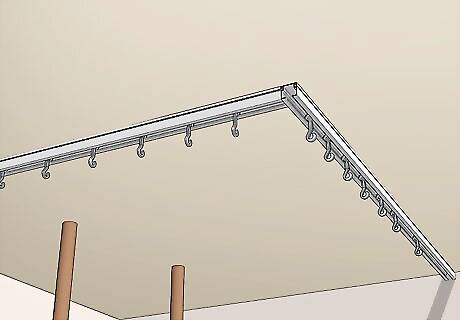
Install the rest of the curtain track. Position the tracks on the ceiling so they wrap around your water heater completely. Hold the track pieces up against the ceiling and feed screws into the holes along their lengths. Make sure the ends of the track line up with the piece you already installed before using your electric screwdriver to secure them in place. You may need to use an angled piece of track if you need your curtain to wrap around in a corner.
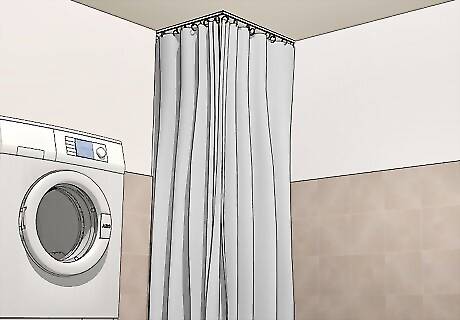
Hang a floor-length curtain from the hooks. Get a curtain that’s the same height as your ceiling so you can hide the entirety of your water heater. Guide the hooks through the holes along the top edge of the curtain and spread it out around the track. Once you’ve placed all the hooks, slide the curtain along the track to conceal your water heater. Get a curtain that matches the other styles in your room so it doesn’t stand out or clash. It’s okay if your curtain is a little bit taller than you need it to be since you can use hem tape to shorten it.
Installing a Faux Cabinet
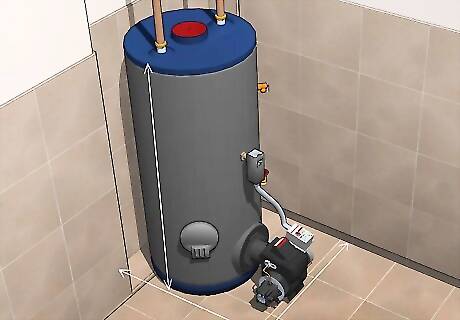
Measure the height, width, and depth of the water heater. Position your tape measure on the floor underneath your water heater and extend the tape up to the top edge. Then measure how far your water heater extends out from each wall that’s next to it. Add about 2–3 inches (5.1–7.6 cm) to each measurement so you have extra space around the heater. Write down your measurements so you don’t forget them later on.
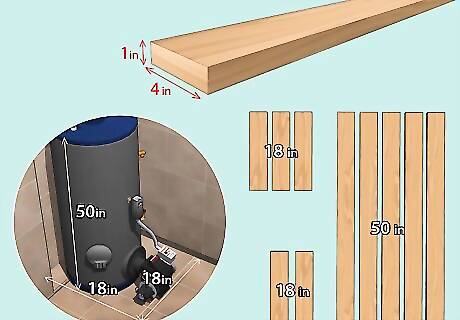
Cut 1 in × 4 in (2.5 cm × 10.2 cm) boards to your measurements. Get enough 1 in × 4 in (2.5 cm × 10.2 cm) lumber to cut out 5 pieces that equal your height measurement, 3 pieces equal to your width, and 2 pieces that are the same as the depth. Put your boards on a sturdy work surface so the piece you’re cutting hangs over the edge. Hold the wood in place with your nondominant hand and cut through the pieces with a handsaw. For example, if the dimensions of the cabinet are 50 by 18 by 18 inches (127 × 46 × 46 cm), then you need 5 pieces that are 50 inches (130 cm) long, 3 pieces that are 18 inches (46 cm), and 2 pieces that are 18 inches (46 cm). This cabinet is meant to use with a water heater that’s in the corner. If your water heater isn’t in the corner, then you need 6 pieces equal to the height, 4 pieces equal to the width, and 2 pieces equal to the depth.
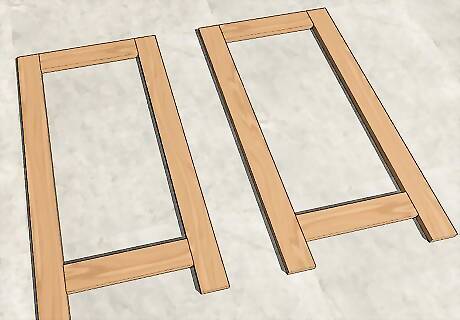
Assemble the boards into 2 rectangular frames for your cabinet. Lay out 2 boards for the height of your cabinet and position 2 boards for the width perpendicularly between them. Make sure the length of the top board is flush with the end of the board on the side. Position the second board so it’s 3–4 inches (7.6–10.2 cm) from the bottom of the side pieces. Screw the pieces together to form a rectangular frame that has 2 legs extending out from the bottom. Repeat the process for the other frame piece. Make sure that there's always enough airflow to the unit. If you starve a gas appliance of the oxygen or fuel it needs, you run the risk of creating carbon monoxide. With this in mind, always leave room between the bottom of the board and the floor. These frames fit around a water heater in the corner of a room. If your water heater isn’t in the corner, then make 3 frames instead.

Cover the large middle section with plywood. After you have the frame assembled, measure the inside window on each panel and add 1 inch (2.5 cm) to each side. Cut pieces of ⁄4 inch (0.64 cm) plywood to size using a handsaw or a table saw. Put the panel on 1 side of the frame and staple around the outer edge of the plywood. Put staples in every 2 inches (5.1 cm) along the edge so it stays in place. You can also use fabric if you want your cabinet to look more decorative.
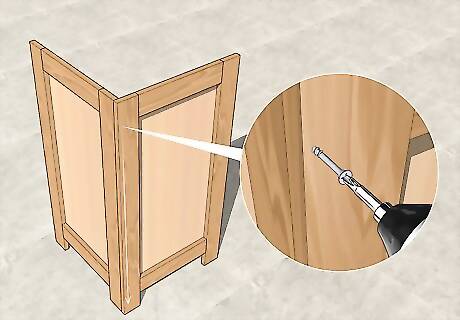
Screw the frames together in the corner to make an L-shape. Stand the frames up on their legs and position them so they form a right angle. Clamp the wood pieces together so they don’t move around and screw them together. Place a screw every 4–5 inches (10–13 cm) so the cabinet doesn’t fall apart. For a water heater that isn’t in the corner, add the third frame to your cabinet to make a U-shape.Tip: Use pocket holes if you don’t want the screws visible when you’re finished.
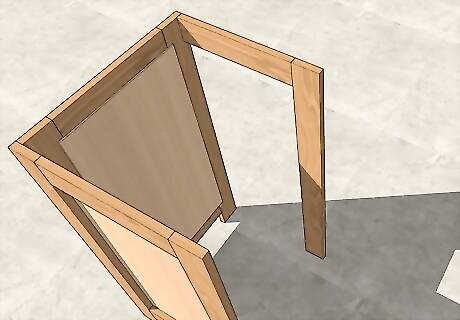
Attach a rear support leg onto your cabinet. Clamp the last short piece to the top corner of the cabinet and screw on an angle bracket to hold it in place. Use the last long piece of wood you cut and screw it onto the end of the short piece so it’s held in place. The extra leg will add additional support so you can put more weight on top of the cabinet when it’s finished. You do not have to add an additional leg if you don’t want, but don’t store any heavy items on top of the cabinet. Don’t add an additional support leg if you made a cabinet that has 3 sides.
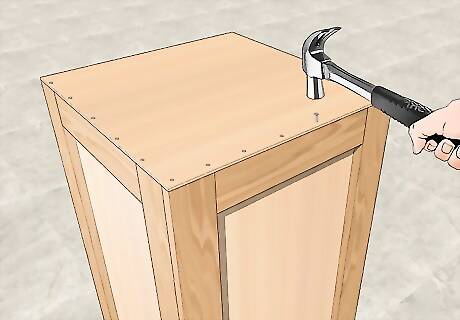
Nail plywood or wood planks on top of the cabinet. Measure the dimensions of the top of your cabinet so you can cut out the top piece. You can either use multiple 1 in × 4 in (2.5 cm × 10.2 cm) planks or a single sheet of plywood. Cut the pieces to size and drive nails every 4 inches (10 cm) along the edge of the cabinet to hold the top piece in place. Make sure the top of your cabinet doesn’t bump into any pipes or else it may not fit well in the space.

Slide the cabinet over your water heater to conceal it. Put the open end of the cabinet so it faces the water heater and make sure the 2 paneled sides face out. Slowly push your cabinet over the water heater. Use the planks or plywood you put on top of the cabinet as a shelf to store items in the room. For example, if your water heater cabinet is in the laundry room, you may keep detergents and laundry supplies on top.



















Comments
0 comment